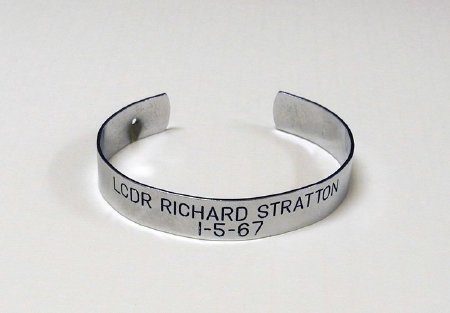Description:
"Until they come home"
On March 8, 1965, the first U.S. combat troops were deployed to the conflict between Communist North Vietnam and its anti-Communist neighbor South Vietnam. By the end of the Vietnam War in 1975, 2,583 Americans were listed as Prisoners of War, Missing in Action, or Killed in Action with body not recovered. During the 1970s, bracelets like this were a popular way to show support for the missing or captive soldiers. More than 5 million POW/MIA bracelets were sold for $2.50 each to raise funds to draw attention to plight of these soldiers. Each bracelet was engraved with the soldier's name, rank, service, loss date, and country of origin. The bracelet seen here commemorates LCDR Richard Stratton, who was a US Navy POW from Maryland, held captive from January 5, 1967 until he was released in 1973.
The bracelet campaign was an outgrowth of Voices in Vital America (VIVA), a conservative student movement formed in the 1960s to counteract campus antiwar protests then sweeping the nation. In 1970, the same year four anti-war protestors were killed at Kent State, student Carol Bates Brown had a chance encounter with Bob Dornan, an Air Force veteran. Dornan wore a bracelet given to him by Vietnamese mountain tribesmen that served as a reminder of the sacrifices of war. Dornan introduced Brown and classmate Kay Hunter to the wives of POWs. The students were so moved by their stories that they travelled to Vietnam to obtain their own bracelets. Bracelet production started small with about 500 made each week and eventually growing to 40,000 per week. Bracelet production ceased in 1976 as the war became increasingly unpopular.
Lifetime Ketchikan resident Karla Sunderland donated this POW bracelet to Ketchikan Museums. It was featured in the 2014-2015 exhibit Continuum: A Ketchikan Timeline at the Tongass Historical Museum.
Ketchikan Museums, KM 2010.2.12.4

